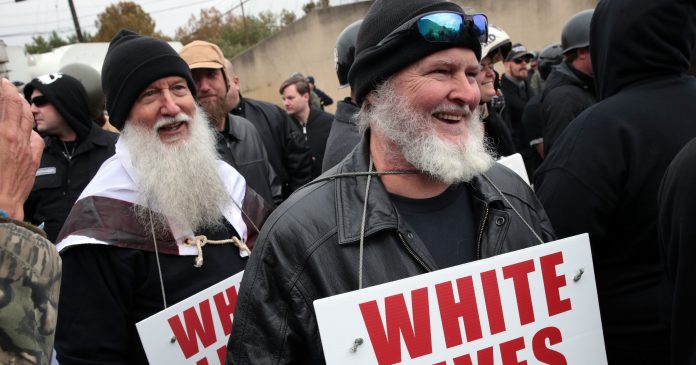The recent upsurge in the popularity of white nationalist and “alt-right” groups in United States has grabbed worldwide attention but the movement has been gaining strength for decades behind the scenes, according to experts.
The groups have been able to move centre stage by successfully tapping into the frustration of white people who have been angered by their “marginalization”, with the current political landscape giving it a further boost.
Keegan Hankes, an analyst for the Southern Poverty Law Center that tracks hates groups said that the President Trump’s election last year “electrified the community”.
The “Unite the Right” rally in Charlottesville, Va., in August saw largescale street clashes between alt-right groups and counter-protestors which resulted in the death of one. Numerous controversial public appearances have since continued across the country backed by legal wins in battles with universities.
Nation’s Traditional Values Attacked
Kyle Bristow, attorney for notorious white nationalist Richard Spencer, and a self-proclaimed “alt-right” activist stated that the government, large corporations, and academia “relentlessly” attack the nation’s traditional values which has only helped the movement grow.
Spencer, executive director of the white nationalist National Policy Institute is a prominent leader of the movement and has given it wide cable television coverage and Internet discussions
The term “alt-right” covers groups who support white nationalism, racism, and populism. White supremacists believe that whites must be the dominant race while white nationalists say that white people are a distinct nation needing political and legal protections.
Extent of Support Not Visible
There are little to no accurate estimates on how many associate with the movement. Many are reluctant to be publicly identified since they fear being attacked and losing their job.
According to the Southern Poverty Law Center, such murkiness is useful as it enables white nationalists to not reveal if their movement is a groundswell or the work of a tiny but effective group of people.
Online support can be indicative. According to the law center over 300,000 people are registered with the oldest white nationalist site, Stormfront, which calls itself as “the voice of the new, embattled white minority.” Spencer’s Twitter account has around 80,000 followers.
White Nationalists Believe Their Free Speech Is Curtailed
White nationalists in online posts claim that the inclusiveness and diversity championed by the country’s mainstream media, liberal arts universities, and public school teachers, wrongfully silences their voices. They insist that there is nothing wrong in saying “I’m proud to be white”
According to experts, the movement lays emphasis on free speech but doesn’t highlight its end game which is to have a nation that has white people at its center with minorities either marginalized or removed.
Adam Leggat, a security consultant who monitors protesters worldwide for the Densus Group stated that the events occurring at the protests was the extension of polarization visible in U.S. politics in the last 10 years. He added that it has been “stoked by a great deal of scaremongering” by some section of media and also social medial social media.”
According to critics the hateful agenda espoused by the “alt-right” groups poses a danger to American values of freedom and equality
Movement Has Adopted New More Subtle Message
White nationalists have today adopted subtle tactics to lure members abandoning the controversial symbols of the past.
- They have left behind the use of cross-burnings, white hoods, and torches typically associated with KKK but retained its call for protecting white culture and value.
- A new addition is the adoption of slogans like “We will not be replaced!” and “Blood and soil!” which have been used by neo-Nazis in Europe.
- Further the movement has borrowed tactics from left-wing groups such as mass protests and legal suits, to make an impact.
According to some white nationalists, their movement does not support violence and is engaged in a clash of ideas in defense of the First Amendment. However recent alt-right protests showed participants carrying handguns and clashes have involved clubs and knives.
Hankes pointed out that white nationalism is “inherently an ideology of violence.”
According to Government Accountability Office, right-wing extremists have killed at least 106 people in the country since S. since Sept. 12, 2001, as compared to the 119 people killed in the same period by radical Islamic extremists.
Redirecting A Powerful Tool
In the Aug. 12 “Unite the Right” rally an “alt-right” supporter rammed his car into a crowd of counter-protesters killing one and injuring 19 others. The accused James Alex Fields Jr., for Ohio has been charged with first-degree murder and the case is going before a grand jury this week.
While federal authorities called the incident domestic terror, white nationalist spun it stating that the woman was killed while escaping from a dangerous situation created by left-wing activists.
Trump’s statements in the aftermath of the attack condemning violence “on many sides” in the attack, further emboldened the movement.
Support May Expand
According to Leggat, a former British Army counterterrorism expert, white nationalists have used media coverage attract new members and become more mainstream. He noted that the group picks causes that may attract people who aren’t as right wing in the hope of gaining new followers .
This kind of rebranding of white nationalist ideas has enabled more and more Americans become public supporters of at least some of their goals.
Brian Levin, of the Center for the Study of Hate & Extremism at California State University in San Bernardino, said that the movement connects not only “race, but also morals and culture.”



